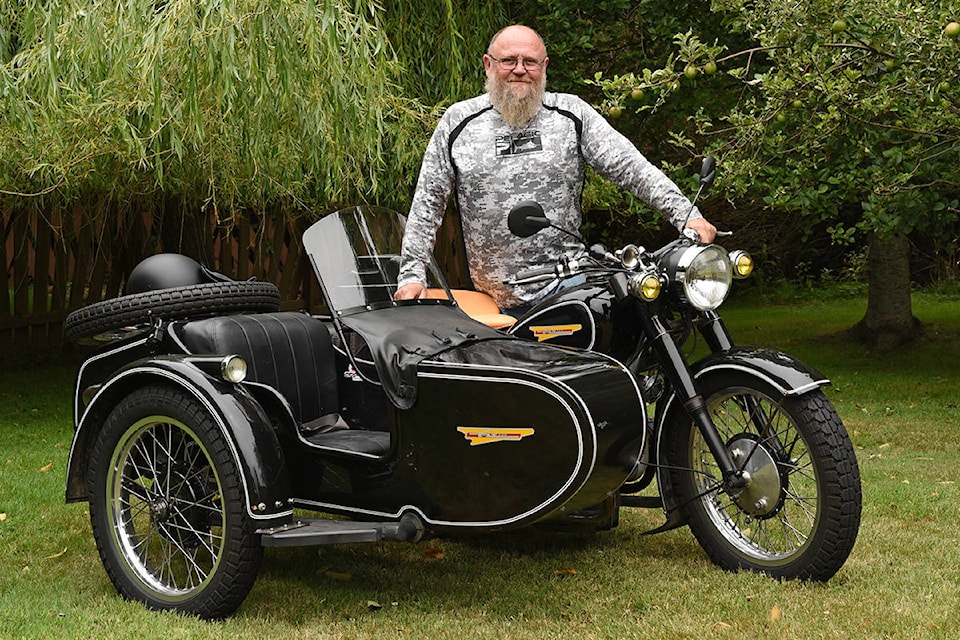- Story by Maggie Jackson Photography by Don Denton
Clive Brown, owner of Pizzability on the West Shore, loves buying, restoring, fixing and riding vintage motorcycles. His garage and basement are filled with vintage bikes. The wall of his garage is lined with Iron Butt Association certificates, a few earned while riding his classic bikes. “You must complete a 1,000 mile (1,600 km) in 24 hours ride, fully documented with receipts etc. with a witness to sign the paperwork at the start and end of the ride, before you do any of the extreme rides” Clive explained. “I think I have about 40 certificates, including numerous extreme and theme rides.”
Clive has always loved vintage motorcycles. “When I was six, I found my grandfather’s Rudge in the garage. I was in awe of all the controls. It was so big and huge and screamed adventure. I wondered what my grandfather did on that motorcycle; where he went and what he saw.”
When he was eleven, Clive’s dream of owning a motorcycle came true. “My older cousin gave me a Triumph Tiger Cub that didn’t run. He told me I could have it if I could fix it. We brought it home and pushed it up and down the streets for a month trying to get it started. It finally started when it was my turn to “ride” it. It must have been a fuel issue, as carburetors get gummed up. Once we got it started, my mother told me it had to go!”
At 14, Clive and his family emigrated from England to Alberta. To Clive’s delight he discovered being 14 meant he could get a motorcycle licence. He bought a Honda CB 100, then a 1976 Suzuki GS750.
Clive’s love of classic bikes is entrenched into his life. “While I love super high-tech bikes, the appeal of the classics is that they aren’t high-tech. They have carburetors and points and if something happens to them I can fix them at the side of the road.”
While he has plenty of classic motorcycles to enjoy, there’s still one that he’d like to get. “My most desired motorcycle is a 1937 Rudge. It was prewar so it had a girder front end with a huge headlight. They’re so classic and unique in the way they were constructed and engineered. It had linked brakes which was unheard of until they were subsequently introduced in the Goldwing.”
Three classics Clive is particularly fond of are his: Jawa Perak, Chang Jiang and FZR250 Yamaha.
“The Jawa Perak has the best history,” Clive said. “The prototype was manufactured and 20,0000 km put on it during the Nazi occupation of Czechoslovakia during WWII. They weren’t allowed to work on anything that wasn’t related to the Nazi war effort. The Czechs, right under the noses of the Nazis, engineered this 250 cc dual exhaust port two stroke motorcycle. They got away with it by putting a fake SS licence plate on the back. When stopped, they told the guards it was a secret SS project. They named the bike Perak, which has two meanings: mythical super hero or a cell of freedom fighters. The motor is a work of art, very art deco to look at. Gearheads see it as a thing of beauty. The bike was introduced in 1948 at the World’s Fair and took the gold medal.”
The Chang Jiang came to Clive partially restored. “These motorcycles are assembled in China from a huge inventory of parts. The Chinese government had set up factories to just have people make things. In many cases they were way overproduced. Once they stopped producing parts, some independents started purchasing them and putting motorcycles together.”
The actual manufactured year of Chang Jiangs are a grey area. “Mine is registered as a 1968 motorcycle, but it could have been put together a few years ago from 1968 parts,” Clive explained. “The vast majority you will see are a compilation of parts put together by independent companies in China. The Chinese government has now put a stop to their export.”
The name Chang Jiang means long river and is named after the Yangtze River. “Most of them came with sidecars although some can be purchased without,” Clive said. “They have a reputation for being incredibly unreliable. However, I toured northern WA with my wife, fully loaded, and it never broke down. The key is preventative maintenance. You have to play with them. I spend two days checking everything and during the trip I check it again at least once a day.”
Then there’s Clive’s newest classic, the 1988 FZR250 Yamaha. “This was a Japanese market motorcycle with an EXUP (electronically controlled) exhaust. This one still has that in pristine condition. It redlines at 18,000 RPM. It’s a race bike for the street.”
JAWA PERAK
Year: 1953
Make: Jawa
Model: Perak 250
Mileage: 3,400 km since restoration
Motor: single cylinder with dual port
250 CC two stroke.
Restoration: Absolutely everything was restored, every nut and bolt.
Manufactured: 1948 to 1954 in Czechoslovakia
CHANG JIANG
Year: 1968
Make: Chang Jiang CJ750
Model: M1S
Mileage: 11,000 km – original mileage
Motor: Boxer 750 CC – 12 volt with overhead valves with reverse.
Looks like a BMW motor
Restoration:
Mostly cosmetic restoration including, seat, handle bar and controls, wheels carburetor, minor cosmetics/nuts/bolts restored. Side car somewhat restored on the interior and the windshield. All lighting upgraded to LED.
Manufactured: early 1960s in China, ceased assembling around 2018
YAMAHA
Year: 1988
Make: Yamaha
Model: FZR250
Mileage: 18,000 original km
Motor: 250 CC, 4 cylinder, 4 stroke
Restoration: Bike is basically all original
Manufactured: This exact model made only in 1988 in Japan
From West Shore Life + Style magazine



